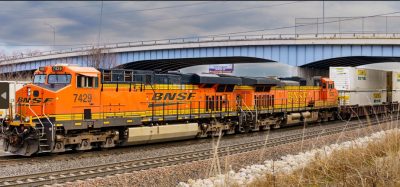Poceirão-Caia PPP call for tenders – a vital infrastructure project
Posted: 27 September 2008 | | No comments yet
On 2 June 2008, the launch of the international call for tenders for the Poceirão-Caia Public-Private Partnership rail infrastructure concession took place, which will be part of the high-speed line from Lisbon to Madrid.
On 2 June 2008, the launch of the international call for tenders for the Poceirão-Caia Public-Private Partnership rail infrastructure concession took place, which will be part of the high-speed line from Lisbon to Madrid.
On 2 June 2008, the launch of the international call for tenders for the Poceirão-Caia Public-Private Partnership rail infrastructure concession took place, which will be part of the high-speed line from Lisbon to Madrid.
The concession will last for 40 years and covers the design, building, financing and maintenance of the railway infrastructures. It also includes the section of line between Évora and Caia, which is part of the conventional freight line running between Sines-Évora-Elvas-Caia and the construction of the new Évora station, which will be built approximately 6km outside of the town.
Direct passenger journey times on the high-speed line between Lisbon and Madrid should take approximately 2 hours and 45 minutes, while the journey from Évora to Lisbon will be made in less than 30 minutes and the 167km section from Poceirão to Caia in 32 minutes.
The construction works on the high-speed line between Poceirão and Caia will begin in 2010 but the complete Lisbon to Madrid service should only open to traffic in 2013.
High speed and conventional networks
The high-speed line will be an electrified UIC gauge double-track, designed to handle speeds of up to 350km/h.
The conventional line between Évora and Caia will be an electrified single-track with Iberian gauge and polyvalent sleepers.
The infrastructure between Poceirão and Caia will include 36 viaducts and bridges with a total length of approximately 16.5km.
These engineering works include an overpass above the A12 motorway near Fernando Pó, and another one over the A6 near the western end of Évora-Norte station. In the proximity of the Portuguese/Spanish border of Caia, the A6 motorway will be changed to overpass the high-speed infrastructure.
This 167km infrastructure will also require the construction of approximately 120 track under and overpasses to ensure the continuity of the roads and lanes cut by the railway line.
The electrical power needed for the operation of the new railway lines between Poceirão and Caia will come from three sub-stations that will be shared by both networks. These substations will be built as part of the concession.
Tender procedure
Applicants will have four months to prepare their initial proposals before they are assessed. RAVE will then hold direct negotiations with the best-placed applicants.
A relevant fact is that this is the first call for tenders to be launched under Portugal’s new Public Contracting Law.
To ensure that the applicants are as well briefed as possible, RAVE has made available to them all the technical studies and background information gathered for the Poceirão-Caia section.
It is expected that the conclusion of the negotiation phase and contract signing will happen in the second semester of 2009.
Financial issues
The Poceirão-Caia Public-Private Partnership is the first PPP tender to be launched for the execution phase of the high-speed project in Portugal. The business and procurement model decided for the Portuguese high-speed project focuses on four main strategic objectives:
- Ensure that the financial burden is admissible for the state
- Minimise the overall risks
- Guarantee the on-time completion of the works
- Ensure a high-quality service
RAVE is focused strongly on the need of ensuring everything is properly managed and that risks have been reduced to a minimum for everyone involved – especially the Portuguese state.
The overall investment for the line between Poceirão and Caia should be approximately €1.450 million, which is approximately €250 million, or some 15%, less than the figures initially announced on the 21 June 2007, when the business and procurement models were presented.
The Poceirão/Caia section is part of two Trans-European Transport Network Priority Projects, which were defined by the European Commission in 2004. The high-speed line between Poceirão and Caia, part of the line between Lisbon and Madrid, is included in Priority Project No. 3 (South-Western Europe high-speed railway axis), while the conventional section between Évora and Caia, part of the freight line Sines-Évora-Elvas-Caia, is included in Priority Project No. 16 (Sines/Algeciras-Madrid-Paris freight railway axis).
€641 million of community funds will be made available for the Poceirão to Caia line – €191 million coming from the 2007/2013 program for Trans-European Transport Networks and €450 million from the National Strategic Reference Framework (Cohesion Funds).
The future concessionaire will be paid in accordance with the performance (in terms of future availability of the railway infrastructure) plus a part for maintenance and another one based on actual future traffic (measured in the number of trains).
RAVE opened a technical and financial analysis process with the European Investment Bank, a few months ago, since this organisation will be closely involved in this project. This involvement with EIB is of great interest to the Portuguese state as it offers more competitive financing conditions than other banking institutions.
Environmental Impact Assessment
The environmental licenses needed for the tender’s launch, in Portugal called Environmental Impact Declarations (DIAs), were last issued for the section of line between Elvas and Caia on the 27 May 2008.
The chosen corridors optimise urban and rural land occupation as well as minimising the eventual negative impacts in the environment.
The DIA’s establishes a complete set of rules to be followed in the design stage by the future concessionaire, with the objective of keeping the impacts on the populations and on the landscape as low as possible, also defining the need for the establishment of environment monitoring programs during the construction phase and when the line comes into operation.
RAVE and A.E.I.E.-AVEP
RAVE (Rede Ferroviária de Alta Velocidade, S.A.) was created by Decree-Law No. 323-H/2000, dated 19 December, and constituted with a capital of €2,500,000 as a public limited company with exclusively public capitals. 60% of the company is held by the Portuguese State and 40% is held by REFER (Rede Ferroviária Nacional, E.P.E.), the national railway infrastructure administrator.
The company’s mission has been defined as; ‘The development and co-ordination of the necessary work and studies to shape decisions on the planning, construction, funding and operation of a high speed rail network to be built in mainland Portugal and its connection with a similar Spanish network’.
Along with ADIF – Administrador de Infraestructuras Ferrovárias (the Spanish railway infrastructure administrator), RAVE created A.E.I.E.-AVEP (an E.I.E.G.-Economic Interest European Grouping called High-Speed SpainPortugal) in 2001, with the objective of studying the ‘High-Speed Rail Connections between Spain and Portugal’.
A.E.I.E.-AVEP is held in equal shares by RAVE, representing the Portuguese state, and ADIF, representing the Spanish. Its statutes stipulate that it is to be presided over by the President of the RAVE Board of Directors, its General-Director is to be appointed by ADIF and it is headquartered in Madrid. Other key functions are divided equally between representatives from both countries.
From the project’s point of view, A.E.I.E.-AVEP plays an especially important role since, from 2001 onwards, it has been the entity responsible for the development of the trans-border axes to be implemented between Portugal and Spain, namely, coordinating the market studies, the technical, environmental and economical feasibility studies, the preliminary design of the infrastructure and the environmental impact studies, as well as the trans-border operation studies and international stations business and funding models studies.
In 2007, special attention was given to preparing applications for the Multi-Annual Program for the Trans-European Transport Network for the period 2007-2013. Its corollary was a significant amount of financial support granted by the European Commission for the Lisbon-Madrid and Porto-Vigo High-Speed rail axes, amounting to €312.7 and €244.1 million, respectively for Évora-Mérida and Ponte de Lima-Vigo sections.
Business Model
In conformance with the guidelines issued by the Portuguese government, on 21 June 2007, RAVE presented its proposed business model for implementing the project for a High-Speed Rail Network, which essentially aims to meet four main strategic objectives:
- To ensure the affordability for the Portuguese State
- To guarantee compliance with deadlines
- To guarantee a high quality of service
- To minimise risks, especially those to be assumed by the Portuguese State
The selection and presentation of the business model for the project, which is based on a model of Public-Private Partnerships (PPPs), was the culmination of extensive groundwork carried out by RAVE since 2003, with the assistance of various national and international consultants and organisations.
The business model selected to develop the project’s railway infrastructure is as follows:
- Five PPPs for the design, construction, financing and maintenance of the railway substructure and superstructure of the three priority axis of the Portuguese High-speed project – Lisbon to Porto, Lisbon to Madrid and Porto to Vigo connections, excluding the Signaling and Telecommunications Systems, for a period of 40 years
- One PPP for the design, supply, installation, financing and maintenance of the Signaling and Telecommunications Systems, for the entire length of the three priority axes of the project, for a period of 20 years
- The Lisbon and Porto stations are to be developed directly by REFER, due to the particular complexity of the interventions to be implemented, and the remaining stations are to be integrated into the respective PPPs of the axes on which they are located (the Coimbra and Braga stations are still being analysed)
- Strategic functions of managing circulation and the allocation of capacity will be entrusted to REFER, as the managing entity of rail infrastructure in Portugal
- At the operations level, the Portuguese State will acquire the rolling stock needed, which will later be allocated to the future operator(s). The definitive model for the operation will only be defined after 2010, as European directives may be later issued on the possible liberalisation of international passenger transport
EU Funding (NSRF and TEN-T)
The High-Speed Rail Network project in Portugal has already been attributed a sum of approximately €1.338 million of EU funding, of which €955 million was allocated by the Portuguese State within the scope of the National Strategic Reference Framework (NSRF) for the period 2007-2013 (Cohesion Fund), and the remaining €383 million was attributed by the European Commission as development support under the Trans-European Transport Network (TEN-T) program.
The latter funding was obtained within the scope of the Multi-Annual Program for 2007-2013, for which applications were submitted in July 2007. This program is essentially aimed at funding large projects, especially trans-border sections, projects that cross natural barriers and those which eliminate existing bottlenecks in Europe.
In this context, the strategy delineated by RAVE consisted of the submission of five applications, namely:
- The Évora-Mérida trans-border section, as a part of the Lisbon-Madrid High-Speed rail axis
- The Ponte de Lima-Vigo trans-border section, as a part of the Porto-Vigo High-Speed rail axis
- The Third Tagus Crossing, in the Chelas-Barreiro corridor, in its High-Speed rail component
- The connection to the planned new Lisbon’s airport
- The Signalling and Telecommunications System for the entire High-Speed Rail Network in Portugal, within the scope of the first phase of the specific category for co-financing the implementation of the European Rail Traffic Management System
The two applications concerning the trans-border sections required extensive coordination with the Spanish government, within the scope of the A.E.I.E.-AVEP, which resulted in the presentation of joint applications by the two countries.
221 projects were presented by 25 member states, requesting a total amount of co-financing of approximately €11.5 billion, more than doubling the available funds (€5.1 billion). The European Commission selected three of the five applications submitted with regard to the High-Speed Rail Network project in Portugal, and attributed the following sums:
- €191 million for the Évora-Mérida trans-border section
- €141 million for the Ponte de Lima-Vigo trans-border section
- €51 million for the Third Tagus Bridge
It is important to note the enormous success that the granting of approximately €383 million of funding from the EU represented for the project. The funding was granted under the aegis of the Trans-European Transport Network and represents approximately 7.5% of the total available funds. This is a remarkable achievement considering the funds were distributed over the 27 member states and countries such as France, Italy and Spain are currently developing far more transport infrastructure projects than Portugal.
Project priorities
As mentioned above, the Lisbon-Madrid and Porto-Vigo (first phase between Braga and Valença) High-Speed rail axes (expected to become operational in 2013) and the Lisbon-Porto axis (expected to become operational in 2015) have been considered to be a priority by the Portuguese government, in order to implement these projects efficiently on the ground.
For the purpose of preparing the Preliminary Studies and the development of Environmental Impact Studies, the axes have been subdivided into sections.
Efforts have been made to ensure not just the creation of sections that are of a similar length, but also to ensure the continuity of the routes along the axes as well as the separation of the entrances into the main cities of Lisbon and Porto.
As in Portugal, the existing conventional gauge is different from the European gauge – the national strategical guidelines for the railway sector establishes the need for the interconnection of both networks, contributing this way for the enhancement of the rail market potential. Along with these politics, RAVE has been pursuing a strategy of using the existing conventional stations for the high-speed network, as it happens in cities like Lisbon, Porto, Coimbra and Leiria.
Another strong pillar of the Portuguese high-speed rail network is the strategic bet on the freight. Lisbon to Madrid, Porto to Vigo and Aveiro to Salamanca axis will be prepared for freight, connecting the biggest national ports and airports to the rising national logistics platforms network, creating new high-capacity corridors to Spain and to rest of Europe.








